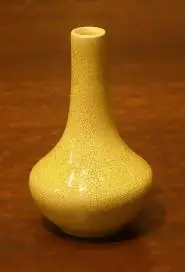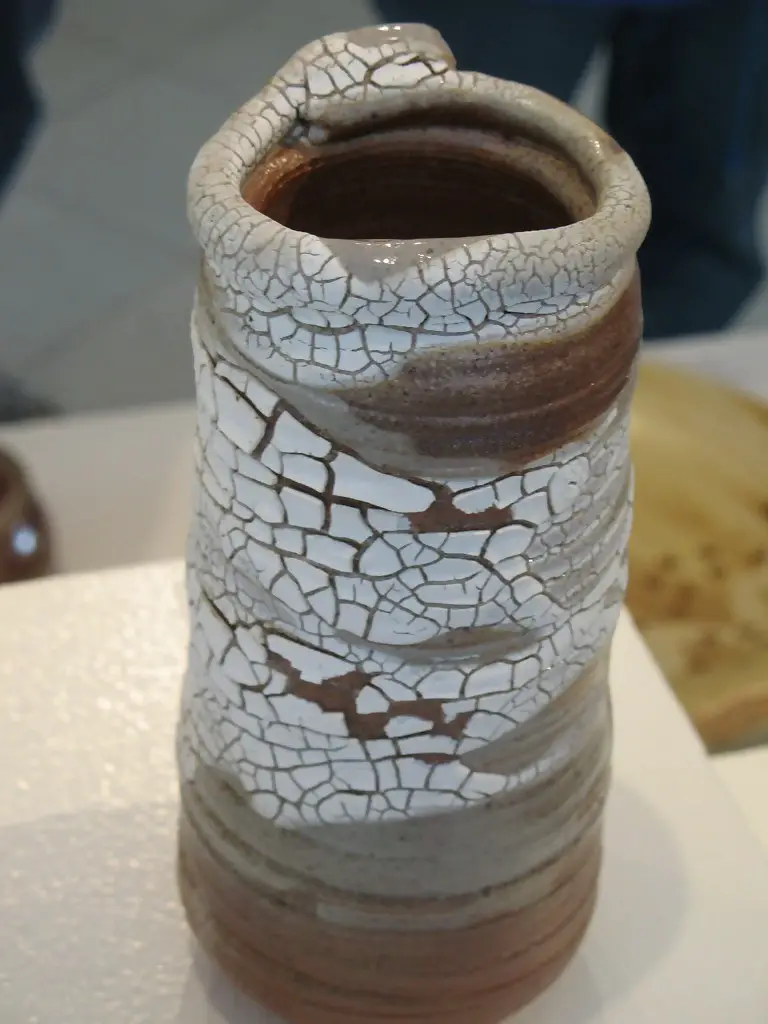I have gotten a lot of questions recently about crackle glaze. I feel I should break down what crackle pottery is all about, its usefulness and why it is so great on pottery. Without wasting time, Crackle pottery is caused by crazing. Crazing is the most common glaze mistake and also very easy to correct. Glazes that have crazed show a fine pattern of cracks in the surface of the glaze. It is very easy to detect by simply breathing on the piece and fogging the glaze surface. Crazing is a result of a discrepancy between the coefficient of expansion of the glaze and the body of the clay. When the glaze is expanding more than the clay body, there will be crazing. You regulate the amount of crazing by varying how much Na2O and K2O are in the pottery. The Na2O and K2O are the oxide elements in the glaze. I have talked extensively on Crazing and other glazing mistakes. You can read more on them by clicking here.

Crackle or crazed glazes are often in form of Snowflake Crackle, Fish Scale Crackle, Ice Crackle glazes. According to Wikipedia, Research has shown that Ge ware has a double crackle effect known as “gold thread and iron wire”. The double crackle effect is where there are two patterns, one with wide and large crackle and the other patter has a finer network. Each of the cracks has the crazing effect heightened by applying a colored stain (also known as colorant), in different colors. There are multiple layers of glaze, and the wider crackle develops first, with the finer one developing inside those sections. The crackle may take some time to appear after firing and is probably mainly caused by rapid cooling and perhaps low silica in the glaze.
Crackle Pottery serves as a means of detecting pottery forgery. Research has shown that Historical Crackle pottery patterns are difficult to reproduce and are therefore a useful tool in authenticating pottery pieces. Modern detection systems rely on feature extraction at crack junctions and image matching to verify the authenticity of artwork with high accuracy.
Why is Crackle pottery still relevant?
Some reasons why people would even consider this include the following:
-
 The design is cool: The fine stretched pattern is one reason a lot of potters think crackle pottery is still relevant till today.
The design is cool: The fine stretched pattern is one reason a lot of potters think crackle pottery is still relevant till today.- The amount of crackle glaze is varied based on the recipe
- It allows for different glaze distinctions: One good thing about crackle pottery is that you can keep adding glazes to beautify and decorate the pottery pieces.
- It is great for Feldspar-based glaze lovers: If you are a fan of Feldspar glazes, you will want this.
- It looks vintage: there is this classy look that comes with crackle glazing. It represents the history of certain cultures in some parts of the world.
Crackle glaze is common on Raku pottery. Raku pottery is known for its crazing effects on the pottery pieces. No wonder Raku is still relevant till today.
Importance of Crackle Glazes
Other importance of crackle glazes in the pottery world today include:
| KEYWORD | DETAILS |
| HISTORY | Historians and Pottery specialists can now trace the history of pottery pieces. |
| clay STRENGTHENING | Glazing compresses the clay body molecules thereby making it rigid |
| WATERPROOFING | Glaze melts and flows evenly over an object which results in a thick water-resistant surface. |
1. History
Crackle Pottery has allowed historians and pottery specialists to be able to trace the history, customs, and cultures of different pottery pieces. According to the History World website, the Greeks started producing fired and unglazed earthenware for storage and cooking purposes back in the 5th century BC. The pots were leaky and unable to hold water until the development of glazes in the 1st century BC in Egypt. The first blue-green glaze commonly known as Egyptian paste and is still popular and being used around the world today. Crackle glazed ceramics were concurrently developed in early China and the Middle East, and traded along the famous Silk Road. Glazed ceramics were popular commodities and the active exchange of ceramic styles and techniques impacted the future development of pottery. Early European pottery and glaze techniques were influenced by eastern ceramics that traveled to Rome. A team of potters traced a crackled pottery piece in a museum back to the origin and the country it was fired 170 years after.
2. Strengthens Clay
Crackle Glazing strengthens the entire clay body of any ceramic vessel. Potters often calculate glaze ratio to the clay body, so the fired glaze fits tightly on the ceramic surface, thereby compressing the clay molecules. Compression results in greater resistance to liquids and increased durability of the object. Crazed objects tend to last for hundreds of years due to its rigidity and its higher expansion ratio than other glazes. Unglazed objects are often broken easily due to their loose clay molecules.

3. Decoration
I don’t have to emphasize on how beautiful and attractive crackle glazing makes pottery look. As earlier said, glazes are silica-based glass constituents that create a smooth, fine glass surface over clay when it is melted at high temperatures. The double crackle variations in the oxides are used both under and over applications of clear glass glaze for coloration and decoration. Today, different crackle glaze oxides are often mixed with other glaze chemicals and are available for potters.
4. Waterproofing
I think it is quite obvious that water is the poison of any form of pottery. But the antidote to this poison is glazing. Glaze melts and flows evenly over an object when heated with temperatures between 1800 and 2400 degrees F–in a ceramics kiln. Crazed glazes make the glaze melts and it coats the surfaces evenly with a thin coating of glass. As the glass cools slowly, the glazed surface turns smooth and solid. The result is a tight surface that is water-resistant and holds liquids effectively over time. You must be careful when you are coordinating the expansion and shrinkage rates of glaze over the clay body, or else you might experience cracking and crazing will occur during the heating and cooling process.
Crackle glazes might be difficult to make, so I usually advise beginners to get a premixed glaze that has higher expansion ratios. You can order yours by clicking here.
In this article, I have discussed what crackle pottery is, the cause of crackle in pottery, the obvious reasons why crackle pottery is still relevant till today and the importance of crackle glazes.






